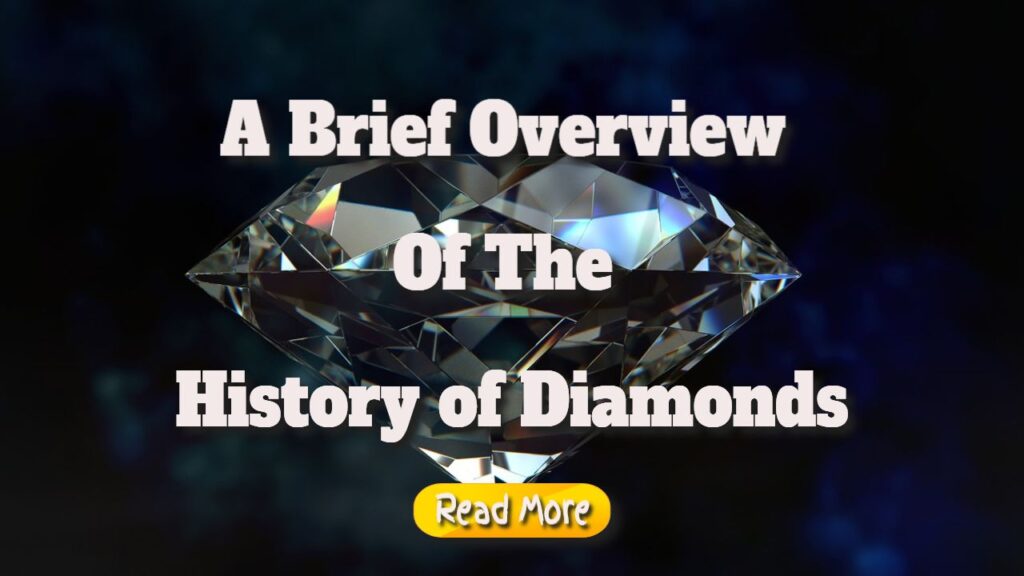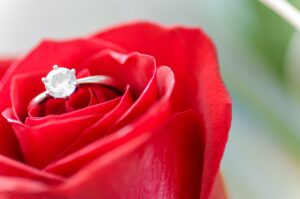A Brief Overview Of The History of Diamonds
Diamonds are the most beautiful, unique, and valuable pieces of jewelry in the world, but they are also the most enigmatic.
The jewels we see in jewelry stores and museums are usually millions of years old, outlasting any astonished observer who is captivated by their beauty.
The diamond is typically regarded as a proclamation of love and dedication that will one day (hopefully) symbolize the end of one phase of a relationship and the beginning of a new, united, everlasting bond.
Most people buy diamonds as an investment in their future and the person they want to spend it with. However, as someone who grew up surrounded by diamonds and works in the diamond industry, I am fascinated by their historical significance and journey as a vital part of our society.
Every diamond has a tale to tell.
The word “diamond” is derived from the Greek word “Adamas,” which means “invincible and unbreakable.”
Before becoming ancient money or a modern symbol of love, diamonds were surrounded by superstition, spirituality, magic, mysticism, and divine belief.
Diamonds, according to Plato, were living beings that embodied divine energies. Anyone who wears a diamond is protected against fire, poison, thieves, water snakes, and evil spirits, according to Hindu mythology.
The Romans believed that wearing diamonds in battle made a warrior stronger and invincible, while others believed that the magical force contained within each stone could heal a wounded or sick person.
The origins of the diamond (before Christ)
According to some, diamonds were discovered in India by the Dravidians between 2500 and 1700 BC during the Bronze Age Indus Valley Civilization.
Others believe the first diamonds were discovered in India about 1000 BC.
Between 400 and 300 BC, the first documented knowledge of diamonds appears in the Sanskrit books Arthashastra and Ratnapariksha.
The first record of diamond trading, Arthashastra, is utilized as a currency or source of revenue.
Ratnapariksha contains the first recorded method of analyzing and classifying the quality or qualities of a diamond.
Both writings describe the diamond’s magical, powerful character, and it is thought that anyone who wears one may “avert danger from himself,” regardless of the threat.
The diamond, according to this literature, is “the jewel above all others” and the most valuable and sought-after commodity in Indian civilization.
The Bible also contains the first references to diamonds being used as tools.
“The guilt of Judah is carved on the tablet of your heart and the horns of your altars with an iron pen and a diamond point.” Jeremiah 17:1
When King of Macedonia Alexander the Great invaded India in 327 B.C., he returned to Europe with diamonds from the region and exported the stones for the first time.
In 120 BC, a Greek traveler named Eudoxus Cysicii saw extensive digging near river floods. This is the first time diamond mining has been mentioned in European history.
Rising Diamond Prices (A.D.)
For hundreds of years, diamonds have been used as money and as a symbol of power and rank. Diamonds were not utilized as jewelry until 1074, when the Queen of Hungary studded her crown with diamonds.
Diamonds began to have an impact on our history during the next thousand years. Royal families and powerful rulers traded them in order to build an alliance and demonstrate their dedication.
The diamond industry flourished, mines cropped out in new places and countries around the world, and diamonds eventually became a symbol of love and fidelity.
In the early 13th century, the Koh-i-Noor (Mountain of Light) diamond was discovered in the mines of Golconda in India.
Because it weighed more than 790 carats, it was given supernatural power, and the belief spread that whoever owned the diamond ruled the world.
Between its discovery and today, it has changed hands countless times, often in nasty, violent conflicts, leading some to believe it was cursed and brought bad luck to its owner.
It is now part of the United Kingdom’s Crown Jewels, set in the Queen Mother’s crown and stored at the Tower of London.
In 1477, Archduke Maximillian of Austria, who was madly in love with Mary of Burgundy, commissioned the first diamond engagement ring, sparking the trend of using diamonds as part of a marriage proposal and starting a tradition that we still follow today.
As the demand for diamonds increased and their applications expanded, so did the supply. In the early 1500s, Vasco da Gama built a direct sea route to India, allowing more diamonds to be sold from India to Europe.
He sold the 116-carat “Tavernier Blue” diamond to Louis XIV of France in exchange for a letter of nobility and 172,000 ounces of pure gold.
It has been on display at the National Museum of Natural History in Washington, D.C. since 1958.
Diamonds had to take on a variety of shapes and sizes as they became more popular in order to stand out from the crowd. In 1520, the “rose cut” diamond was designed to resemble a rose, and in 1562, Mary Queen of Scots gave Queen Elizabeth a heart-shaped diamond ring as a token of their friendship.
Jean-Baptiste Tavernier, a French adventurer and gem dealer, discovered the Hope diamond in the Golconda mines during one of his six trips to India in 1638.
I’m excited to see where the diamond industry goes next when new diamonds are unearthed and old ones are mined.
The world is always changing, but one constant has been the value and importance of diamonds.
They are subjected to economic ups and downs, currency changes, value losses, as well as generational and cultural shifts.
Their beauty, strength, and longevity are unparalleled in natural materials.
When you wear a diamond, you are wearing something more than just a piece of art or a gesture of affection. You’re dressed like a historical figure.
The post A Brief Overview Of The History of Diamonds appeared first on https://gqcentral.co.uk







Comments are closed